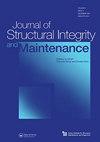用贝叶斯正则化神经网络预测四元混合混凝土的抗压强度
IF 3.1
Q2 ENGINEERING, CIVIL
Journal of Structural Integrity and Maintenance
Pub Date : 2021-09-15
DOI:10.1080/24705314.2021.1892572
引用次数: 14
摘要
摘要用普通硅酸盐水泥(OPC)生产的混凝土以及添加的辅助材料增加了非线性水平。由于这种非线性和数值建模难度的增加,人们越来越关注于探索计算智能模型,如人工神经网络(ANN),以估计不同的混凝土特性。在本研究中,用OPC、粉煤灰(FA)、偏高岭土(MK)和稻壳灰(RHA)开发了一种四元共混混凝土。实验数据进一步用于训练所提出的ANN模型,以近似其抗压强度。使用三种不同的正则化算法对所提出的神经网络模型进行了训练和优化;缩放共轭梯度“trainsc”(SCG)、Levenberg–Marquardt“trainlm”(LM)和贝叶斯正则化“trainbr”(BR)算法。构成四元混合物的OPC、FA、MK和RHA的百分比比例和养护天数是用作输入变量的五个特征,而每个混凝土混合物的抗压强度是输出变量(目标)。研究发现,用贝叶斯正则化函数优化的神经网络表现最好,相关系数最高,MAE、MSE和RMSE最低。从人工神经网络方法获得的结果显示出与实验观察相比的显著改进。本文章由计算机程序翻译,如有差异,请以英文原文为准。
Predicting the compressive strength of a quaternary blend concrete using Bayesian regularized neural network
ABSTRACT Concrete produced with ordinary Portland cement (OPC) along with insertion of supplementary materials increases the level of nonlinearity. Due to this increased non-linearity and difficulty in modeling numerically, the focus has increased on the exploration of computational intelligent models like artificial neural network (ANN) to estimate different concrete properties. In this study, a quaternary blend concrete was developed with OPC, fly ash (FA), metakaolin (MK) and rice husk ash (RHA). The experimental data were further used in training the proposed ANN models to approximate its compressive strength. The proposed neural network models were trained and optimized using three different regularization algorithms; the scaled conjugate gradient “trainsc” (SCG), Levenberg–Marquardt “trainlm” (LM) and Bayesian regularized “trainbr” (BR) algorithms. The percent proportion of OPC, FA, MK and RHA making up the quaternary blends and curing days are the five features used as input variables, while the compressive strength of each of the individual concrete mixture is the output variable (target). It was found out that ANN optimized with Bayesian regularization function performed best with the highest correlation coefficient, and lowest MAE, MSE and RMSE. The results obtained from the ANN approach show significant improvement with the experimental observations.
求助全文
通过发布文献求助,成功后即可免费获取论文全文。
去求助
来源期刊

Journal of Structural Integrity and Maintenance
ENGINEERING, CIVIL-
CiteScore
3.90
自引率
9.50%
发文量
24
 求助内容:
求助内容: 应助结果提醒方式:
应助结果提醒方式:


